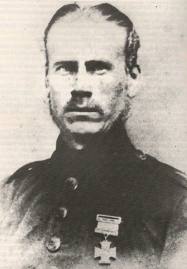Next week I am off to North America to see what I can find out about Hugh Mahon’s time there from 1869 to 1880. Mahon, the Irish-Australian politician who is the subject of a biography I am researching was a 12 year old schoolboy when the family landed in New York City in March 1869. From there they travelled to Ontario, Canada, where they lived for four years on a farm in Oxford County before returning to New York State and settling in Albany, where Hugh trained as a printer and journalist.
By 1880 the 23-year-old Hugh was back in Ireland, editing the staunchly nationalist New Ross Standard and heavily involved in nationalist and Land League politics that eventually led to his imprisonment in Kilmainham Gaol in 1881 and his emigration to Australia the following year. Methinks he learned more than the newspaper business while living in the Fenian homeland across the Atlantic. But evidence is required before speculation, however plausible, can be called fact.
If time permits, I would like to trace another Irishman with Canadian and Australian links whose life was influenced by the Fenians, though in a completely different way. Aisling Society member Myles Mooney put me on to the story of Timothy O’Hea (1846-1874), a soldier from Bantry, County Cork who was awarded the Victoria Cross for gallantry in putting out a fire in an ammunition wagon that was attached to a passenger train. The incident occurred at Danville, Quebec on 9 June 1866 when the ammunition was being transported to the loyalist forces defending Fort Erie from Fenian raiders who had crossed the border from New York State. In total disregard for his own life O’Hea entered the wagon and extinguished the fire, thereby saving the lives of the passengers. His was the first (and perhaps the only) VC awarded for bravery other than in the face of an enemy.
A few years later O’Hea emigrated to New Zealand, where he served as a policeman, and then to Australia. In June 1874 he joined an expedition led by Andrew Hume to search for Adolf Glassen, believed by many to have been the lone survivor of Ludgwig Leichhardt’s ill-fated 1848 expedition to south-west Queensland. For a quarter of century the improbable, if not bizarre, story of Glassen’s survival when the rest of the expedition had perished enticed foolhardy explorers to venture into outback Australia in search of the man who could tell them of Leichhardt’s demise. Some suffered the same fate as Leichhardt and his men, including the hero of Danville, Timothy O’Hea VC. Or did he?
The story has been told numerous times, including by the celebrated author of Australian exploration and bushranging Frank Clune in “The Man who Found Leichhardt”. But in 2005 Elizabeth Reid suggested in The Singular Journey of O’Hea’s Cross that the man who died in the desert was not Timothy O’Hea but his brother John, who had assumed his identity. Hmm, what was I saying about evidence and speculation.
In either case it is an interesting story which I had not heard before and I am grateful to Myles for alerting me to it as I prepare to uncover the story of another Irishman with links to Canada, Australia and perhaps Fenianism. But Canada like Australia is a vast country and Danville is a long way from Oxford County. So, the search for Timothy O’Hea might have to wait for another time.

